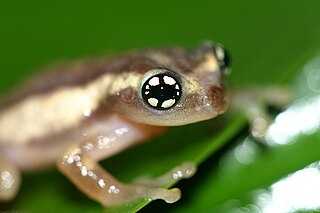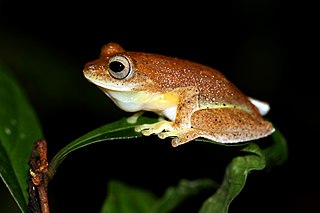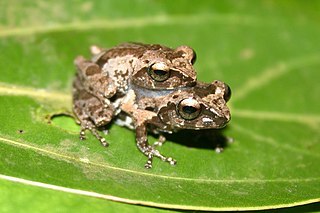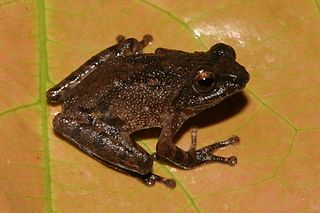
The Rhacophoridae are a family of frogs in tropical sub-Saharan Africa, South India and Sri Lanka, Japan, northeastern India to eastern China and Taiwan, south through the Philippines and Greater Sundas, and Sulawesi. They are commonly known as shrub frogs, or more ambiguously as "moss frogs" or "bush frogs". Some Rhacophoridae are called "tree frogs". Among the most spectacular members of this family are numerous "flying frogs".

The Rhacophorinae are a subfamily of frogs in the family Rhacophoridae. They range from tropical Africa and Asia to temperate China and Japan.

Polypedates is a genus of frogs in the family Rhacophoridae, the shrub frogs and Paleotropic tree frogs. They belong to subfamily Rhacophorinae. Members of this genus are collectively known as whipping frogs. They occur in eastern and southern Asia.

Rhacophorus lateralis is a rhacophorid tree frog endemic to the Western Ghats in South India. It has several common names: small tree frog, Boulenger's tree frog, small gliding frog, and winged gliding frog. After its original description in 1883 by George Albert Boulenger, the frog was rediscovered in Coorg in 2000 and has since been found in many parts of the Western Ghats around southern Karnataka and northern Kerala. Along with R. malabaricus, it is one of the few anuran amphibians in India that constructs its nest above the ground using leaves.

Raorchestes ochlandrae is a species of shrub frog in the family Rhacophoridae. It is endemic to the Western Ghats, India. This species of the oriental shrub frog was first described from Kakkayam Reserve Forest of Calicut district, Kerala state, in the southern Western Ghats in 2007 but has since been recorded at many other sites along the Western Ghats. The specific name ochlandrae refers to microhabitat of the species, bamboo Ochlandra setigera.

Raorchestes anili, known commonly as Anil's bush frog, is a species of frog in the family Rhacophoridae.

Mercurana is a genus of arboreal frogs belonging to the family Rhacophoridae. The genus was named from the only known species Mercurana myristicapalustris, which was described in 2013 from the Western Ghats of Kerala, India. The generic name was derived from and given as a tribute to Freddie Mercury, the late vocalist of the British rock band Queen, in combination with the Latin name for "frog". The frog is different from other related frogs in that it has extensively webbed toes, lives only in swampy lowlands, and lays its eggs on mud with which it carefully mixes leaf litter.

Ghatixalus is a genus of frogs in the family Rhacophoridae, subfamily Rhacophorinae. They are endemic to the Western Ghats of southern India. They are the sister taxon to a larger clade consisting of Chiromantis, Feihyla, Taruga, Polypedates, and Rhacophorus. The name of the genus combines words "Ghats" and "Ixalus". The former refers to the Western Ghats, and the latter to now-abandoned genus name that lives as the suffix in many generic names for rhacophorid frogs.

Raorchestes agasthyaensis, the Agasthiamalai bushfrog, is a frog found in the Western Ghats of Kerala, India, particularly in Bonacaud near Ponmudi as well as nearby areas of Thiruvananthapuram and Kollam districts. The species is named after Agasthyamalai, its type locality.

Raorchestes crustai is a species of frog of the genus Raorchestes found in Bonacaud in the Western Ghats of Kerala in India. It has been observed between 600 and 1500 meters above sea level.

Raorchestes johnceei is a species of frog of the genus Raorchestes found in Bonacaud in the Western Ghats of Kerala in India. It has been observed between 900 and 1300 meters above sea level.

Raorchestes kadalarensis is a species of frog of the genus Raorchestes found in Kadalar near Munnar in the Western Ghats of Kerala in India. This frog has been observed between 1300 and 1700 meters above sea level.

Raorchestes manohari is a species of frog of the genus Raorchestes found in Bonacaud in the Western Ghats of Kerala in India. The species is named after T. M. Manoharan, Principal Chief Conservator of Forests, Kerala.

Raorchestes ravii is a species of frogs of the genus Raorchestes found in Naduvattam in the district of Nilgiris in Tamil Nadu, India, about 1890 meters above sea level. The species is named after Ravi Chandran, an enthusiast from Wayanad who discovered the species.
Raorchestes thodai or the Thoda bush frog is a species of frog of the genus Raorchestes found in Ooty in the Nilgiris district of the Western Ghats of Tamil Nadu in India. Scientists have observed it in the type locality, 1980 meters above sea level. The species is named after the Thoda tribe who dwell in the region.
Raorchestes theuerkaufi is a species of frog of the genus Raorchestes found in the tea estates of Kadalar near Munnar, Idukki district, in the Western Ghats of Kerala in India. The species is named after Wolfgang Theuerkauf, a botanist and director of the Gurukula Botanical Sanctuary in Wayanad, Kerala.

Utham's tree frog is a species of frog of the genus Raorchestes found in Gavi, Pathanamthitta district, in the Western Ghats of Kerala in India. Scientists first observed it near, near a cardamom plantation in Gavi, 1000 meters above sea level. The species is named after two naturalists, bird photographer, P.K. Uthaman, and Deputy Conservator of Forests, K.V. Uthaman.

Raorchestes silentvalley or Silent Valley bushfrog is a species of tree frog endemic to the Nilgiri Hills of southern India and belongs to the species-rich Asian genus Raorchestes. The species was described in June, 2016 and has been found to have a very restricted distribution on the southwestern slopes of the Nilgiri Hills in the Silent Valley National Park. This frog has been observed 2100 meters above sea level in Silent Valley National Park.
Raorchestes lechiya, or Lechiyappan's bush frog, is a species of frog in the family Rhacophoridae. It is endemic to India. Scientists know it exclusively from the type locality: 2023 meters above sea level in Silent Valley National Park. This frog has been observed between 1800 and 2200 meters above sea level.
Ghatixalus magnus, the large-sized Ghat tree frog, is a species of frog in the subfamily Rhacophorinae. It is endemic to India, in the southern Western Ghat mountains, between the Palakkad Gap and Shencottah Gap.















